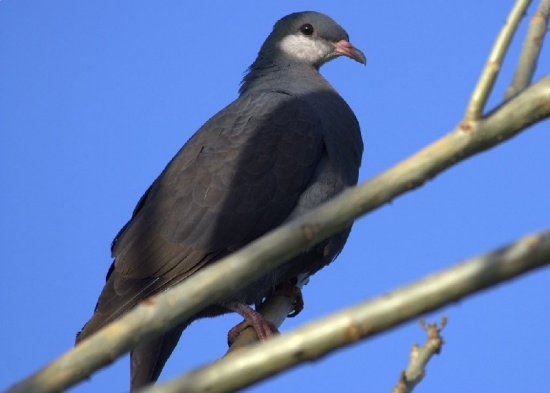(Removed incomplete.) |
|||
| (16 intermediate revisions by 7 users not shown) | |||
| Line 1: | Line 1: | ||
| − | ;Columba vitiensis | + | ;[[:Category:Columba|Columba]] vitiensis |
| − | [[Image:Metallic_Pigeon.jpg|thumb|550px|right|Photo by Matalevu]] | + | |
| − | + | '''Alternative name(s): White-throated Pigeon''' | |
| − | + | [[Image:Metallic_Pigeon.jpg|thumb|550px|right|Subspecies ''vitiensis''. Photo by Matalevu <br/>Photo taken: Pacific Harbour, Fiji | |
| + | ]] | ||
==Identification== | ==Identification== | ||
| − | + | 37-41 cm. | |
| − | + | *crown purple and green | |
| − | + | *wing and uppertail coverts black | |
| − | + | *iris yellowish red | |
| − | + | *bill yellow | |
| − | + | *orbital skin red | |
| − | + | *chin and ear coverts white or grey (subspecies dependent) | |
| − | + | *feet purple | |
| + | Sexes are similar. Immatures are duller than adults. | ||
| − | [ | + | ==Distribution== |
| − | + | [[Indonesia]], the [[Philippines]], [[New Guinea]], [[Solomon Islands]], [[Fiji]], [[New Caledonia]], [[Samoa]]. | |
| + | ==Taxonomy== | ||
| + | Some authorities restrict "Metallic Pigeon" to subspecies ''metallica'' (i.e. ''C. metallica''), placing others (at least ''griseogularis'' and ''halmaheira'' [[#References|[2]]]) into "White-throated Pigeon", ''C. vitiensis''. Reference [[#References|[2]]] regards the differences as minor, suggesting that the plumage of ''griseogularis'' is transitional between the forms. | ||
| + | ====Subspecies==== | ||
| + | Clements recognises the following subspecies [[#References|[1]]]: | ||
| + | *''C. v. griseogularis'': Philippines, Sulu Archipelago and islands off northern Borneo | ||
| + | *''C. v. anthracina'': Palawan and adjacent islands (Calauit, Comiran, and Lambucan), Philippines | ||
| + | *''C. v. metallica'': Lesser Sundas | ||
| + | *''C. v. halmaheira'': Banggai, Sula islands, Kai, Moluccas to New Guinea and Solomons | ||
| + | *''C. v. leopoldi'': Vanuatu | ||
| + | *''C. v. hypoenochroa'': New Caledonia, Isle of Pines and Loyalty Islands | ||
| + | *''C. v. vitiensis'': Fiji Islands | ||
| + | *''C. v. castaneiceps'': Western Samoa (Savai'i, Apolima, Manono and Upolu) | ||
| + | ==Habitat== | ||
| + | Occurs in lowland and montane forests and edges, often close to human settlements on small islands. Forages both in trees and on the ground. | ||
| − | + | ==Behaviour== | |
| − | + | The diet includes fruits, grains, seeds and berries. | |
| − | |||
| + | Lays 1-2 eggs. | ||
| + | ==References== | ||
| + | #{{Ref-Clements6thOct22}}#{{Ref-Eatonetal21}} | ||
==External Links== | ==External Links== | ||
| − | {{GSearch|Columba | + | {{GSearch| "Columba vitiensis" {{!}} "Metallic Pigeon" {{!}} "White-throated Pigeon" }} |
| − | + | {{GS-checked}}1 <br /><br /> | |
| − | + | [[Category:Birds]] [[Category:Columba]] | |
| − | [[Category:Birds]] | ||
Latest revision as of 16:40, 21 December 2023
- Columba vitiensis
Alternative name(s): White-throated Pigeon
Identification
37-41 cm.
- crown purple and green
- wing and uppertail coverts black
- iris yellowish red
- bill yellow
- orbital skin red
- chin and ear coverts white or grey (subspecies dependent)
- feet purple
Sexes are similar. Immatures are duller than adults.
Distribution
Indonesia, the Philippines, New Guinea, Solomon Islands, Fiji, New Caledonia, Samoa.
Taxonomy
Some authorities restrict "Metallic Pigeon" to subspecies metallica (i.e. C. metallica), placing others (at least griseogularis and halmaheira [2]) into "White-throated Pigeon", C. vitiensis. Reference [2] regards the differences as minor, suggesting that the plumage of griseogularis is transitional between the forms.
Subspecies
Clements recognises the following subspecies [1]:
- C. v. griseogularis: Philippines, Sulu Archipelago and islands off northern Borneo
- C. v. anthracina: Palawan and adjacent islands (Calauit, Comiran, and Lambucan), Philippines
- C. v. metallica: Lesser Sundas
- C. v. halmaheira: Banggai, Sula islands, Kai, Moluccas to New Guinea and Solomons
- C. v. leopoldi: Vanuatu
- C. v. hypoenochroa: New Caledonia, Isle of Pines and Loyalty Islands
- C. v. vitiensis: Fiji Islands
- C. v. castaneiceps: Western Samoa (Savai'i, Apolima, Manono and Upolu)
Habitat
Occurs in lowland and montane forests and edges, often close to human settlements on small islands. Forages both in trees and on the ground.
Behaviour
The diet includes fruits, grains, seeds and berries.
Lays 1-2 eggs.
References
- Clements, J. F., T. S. Schulenberg, M. J. Iliff, T. A. Fredericks, J. A. Gerbracht, D. Lepage, S. M. Billerman, B. L. Sullivan, and C. L. Wood. 2022. The eBird/Clements checklist of Birds of the World: v2022. Downloaded from https://www.birds.cornell.edu/clementschecklist/download/
- Eaton, JA, B van Balen, NW Brickle, FE Rheindt 2021. Birds of the Indonesian Archipelago (Greater Sundas and Wallacea), Second Edition. Lynx Editions. ISBN978-84-16728-44-2
External Links
GSearch checked for 2020 platform.1




